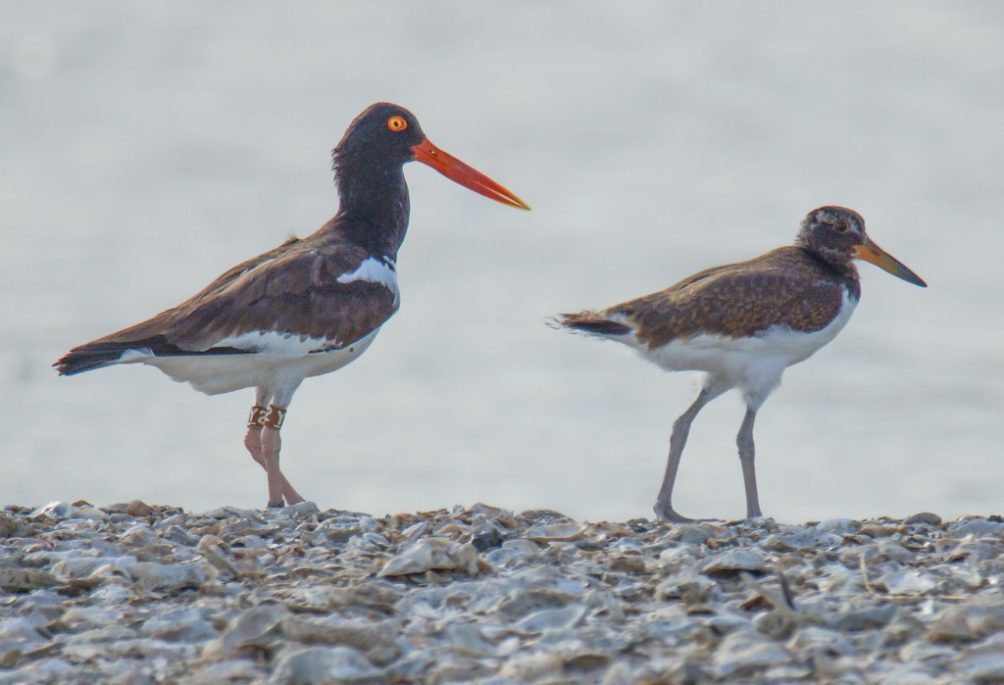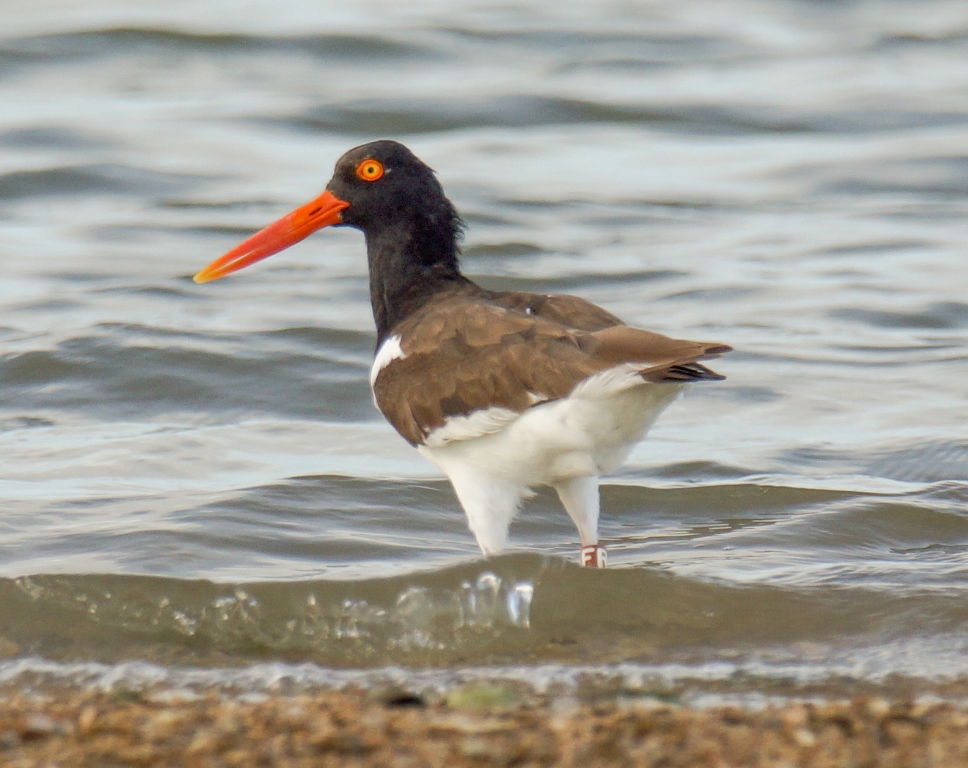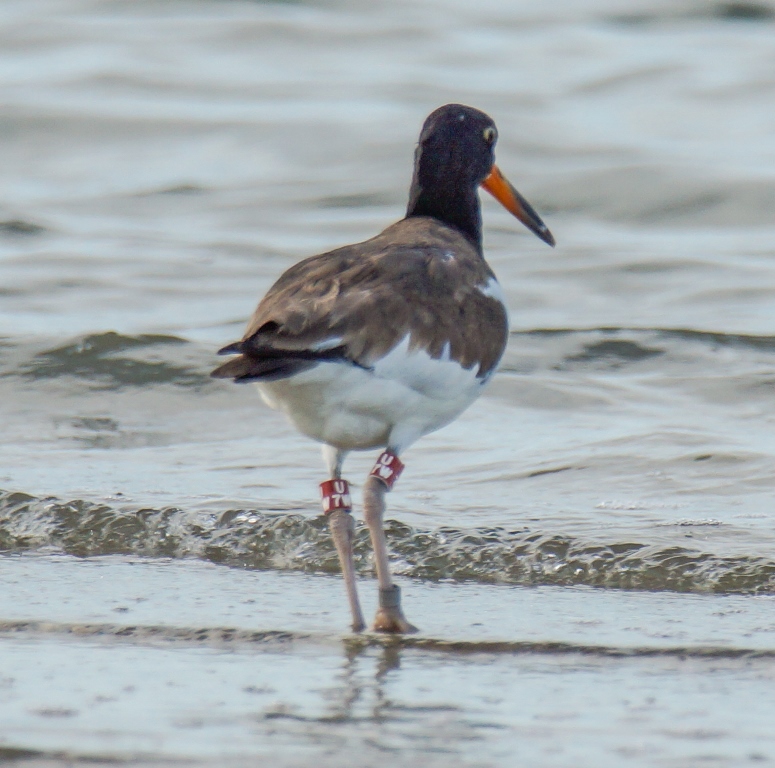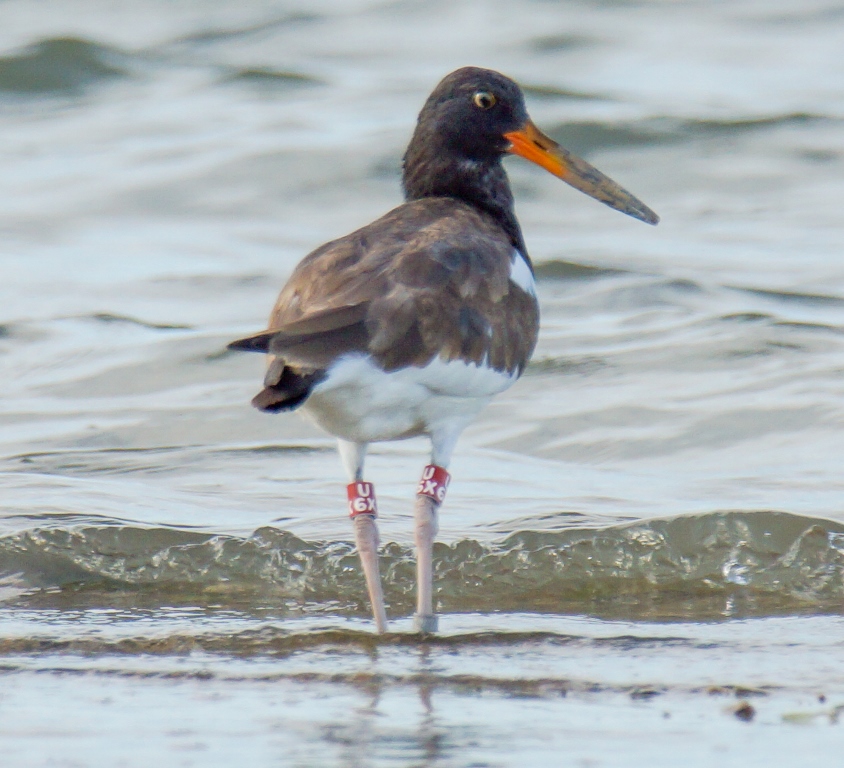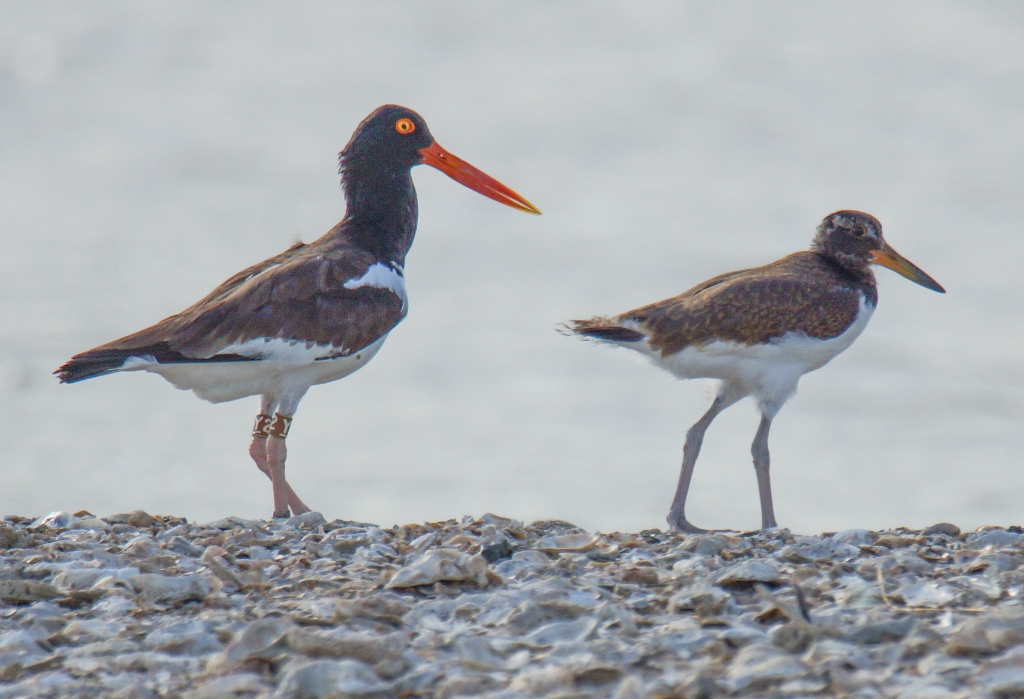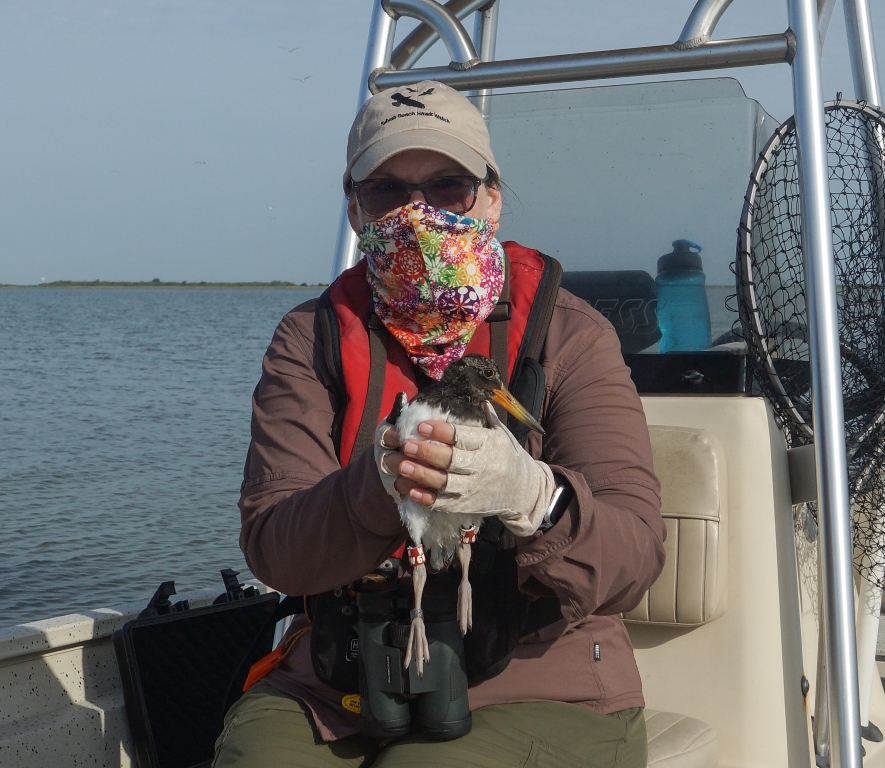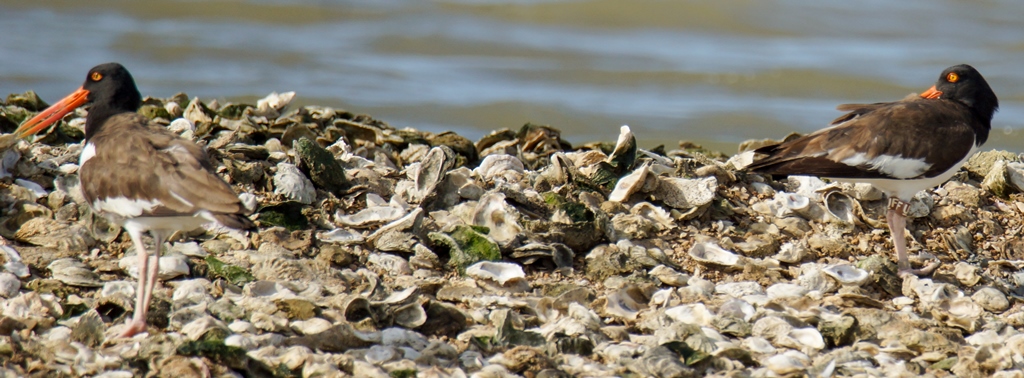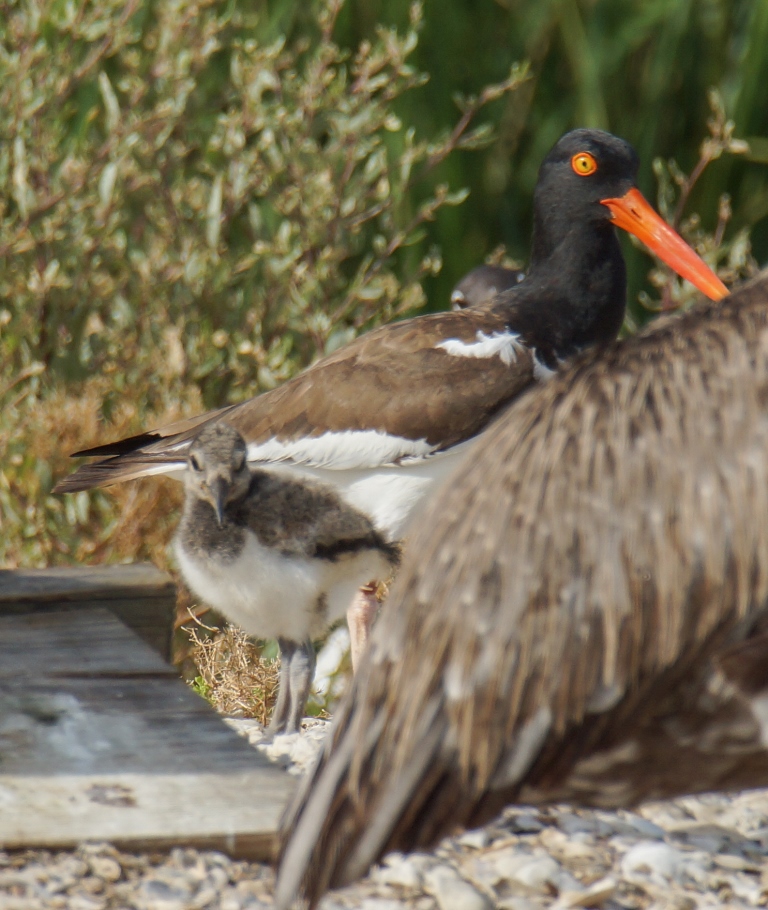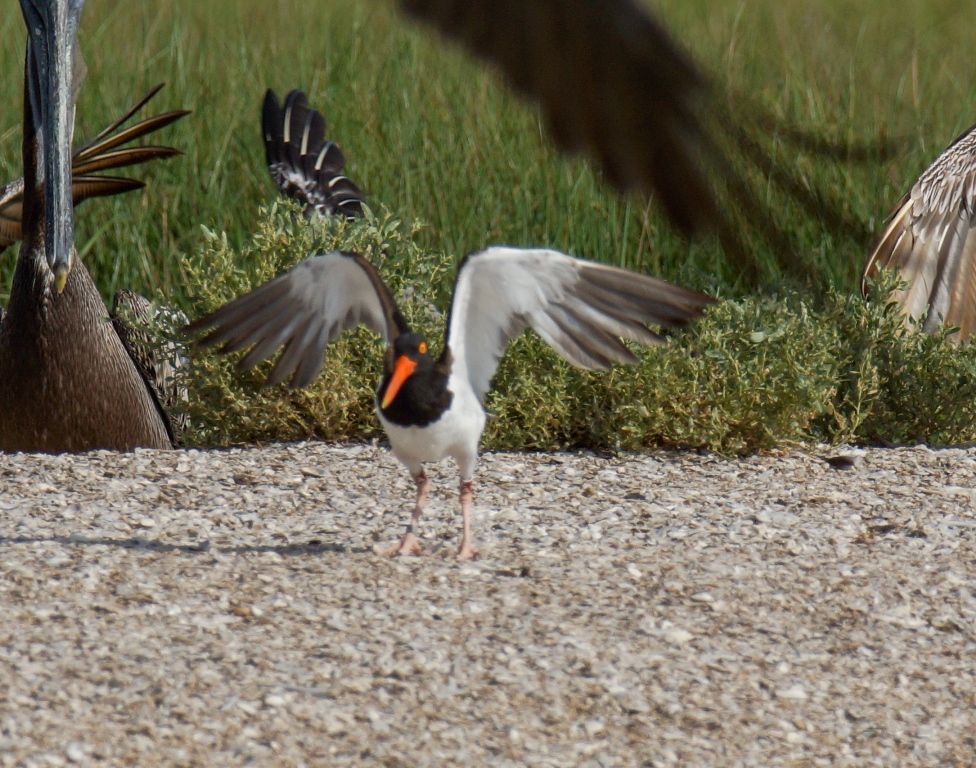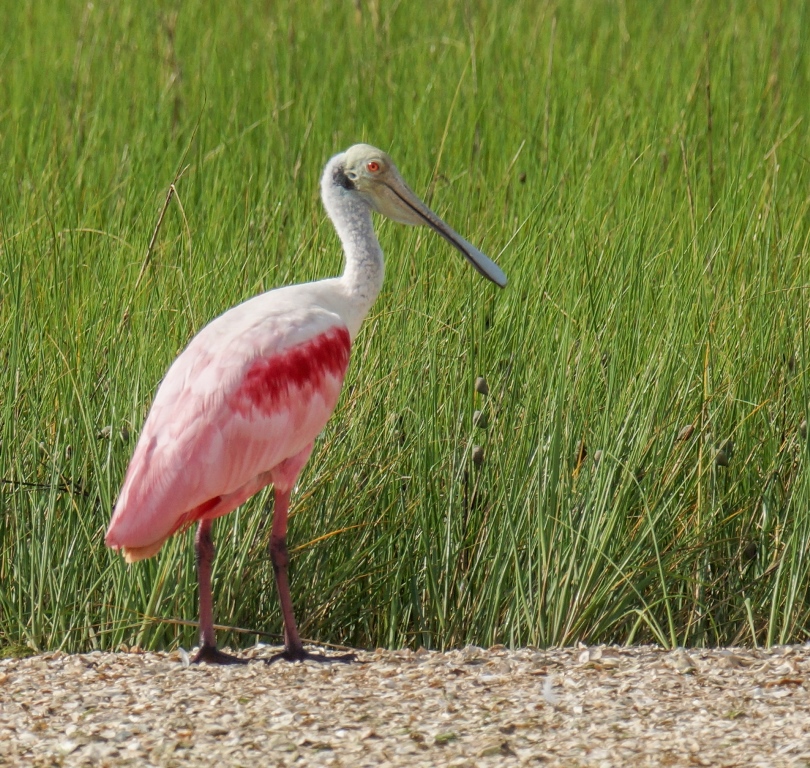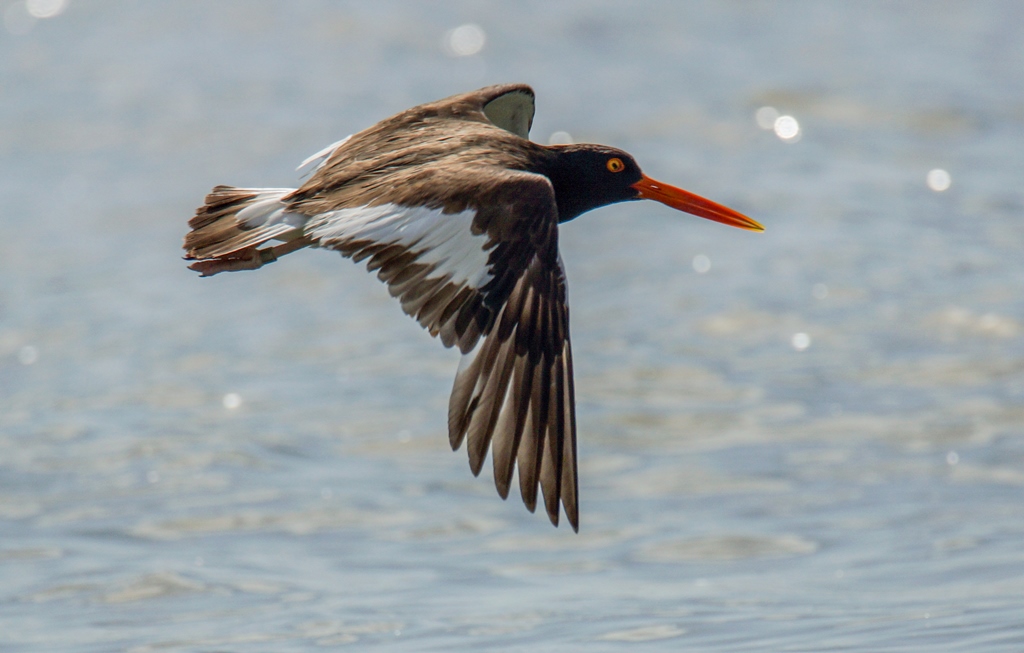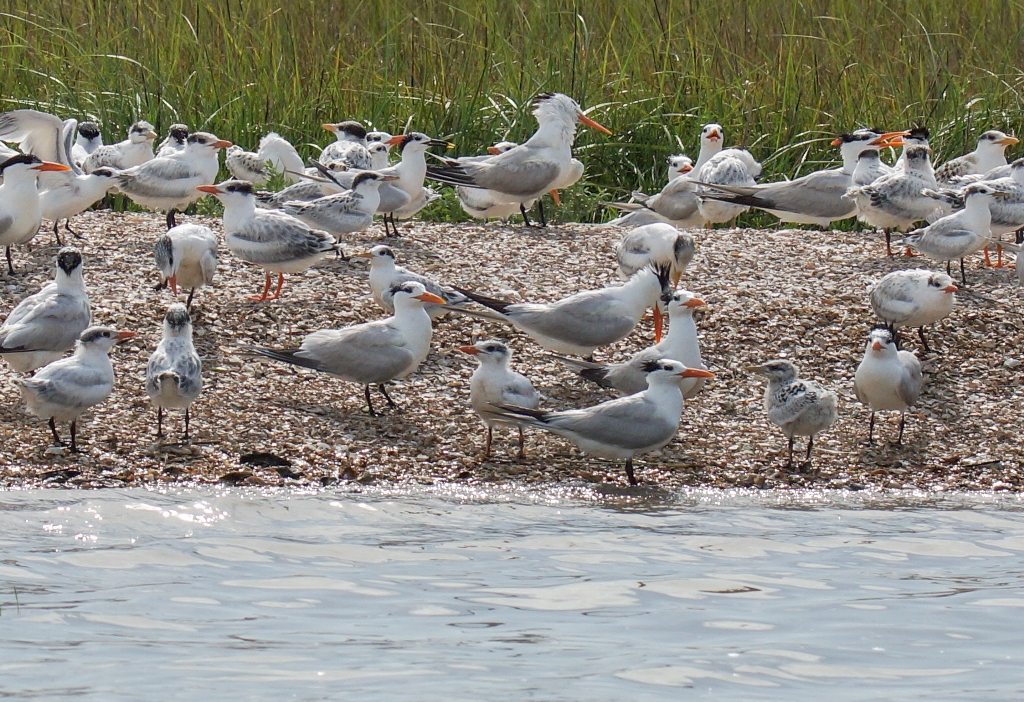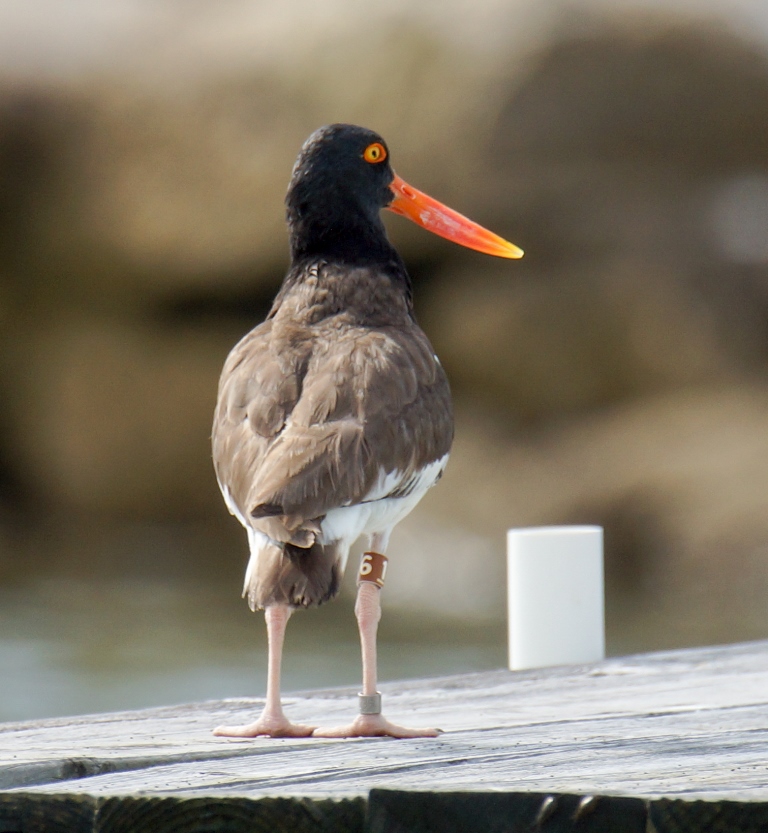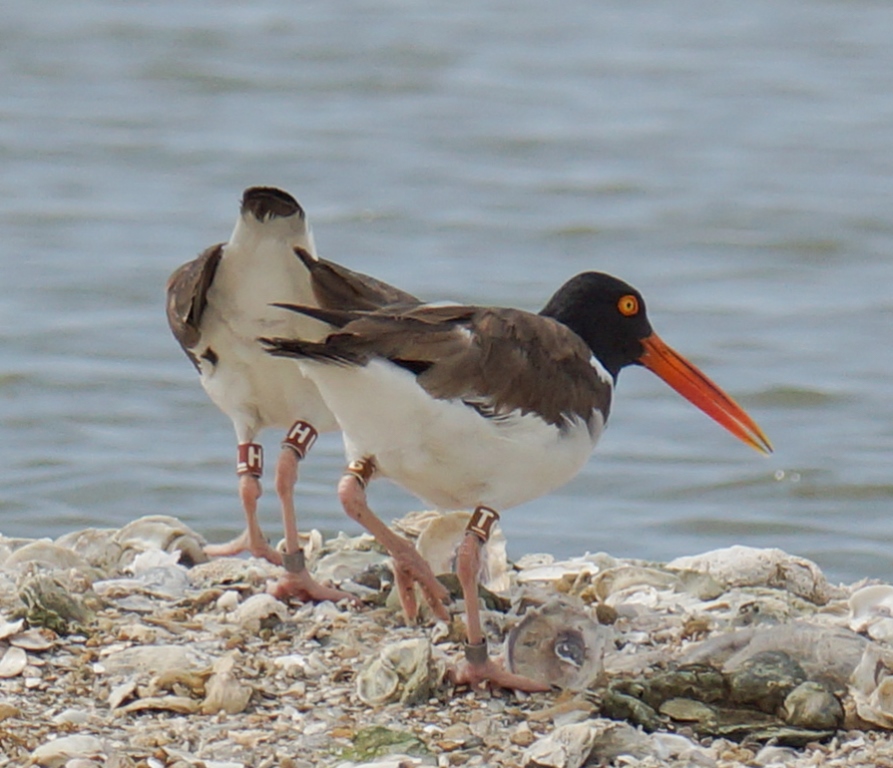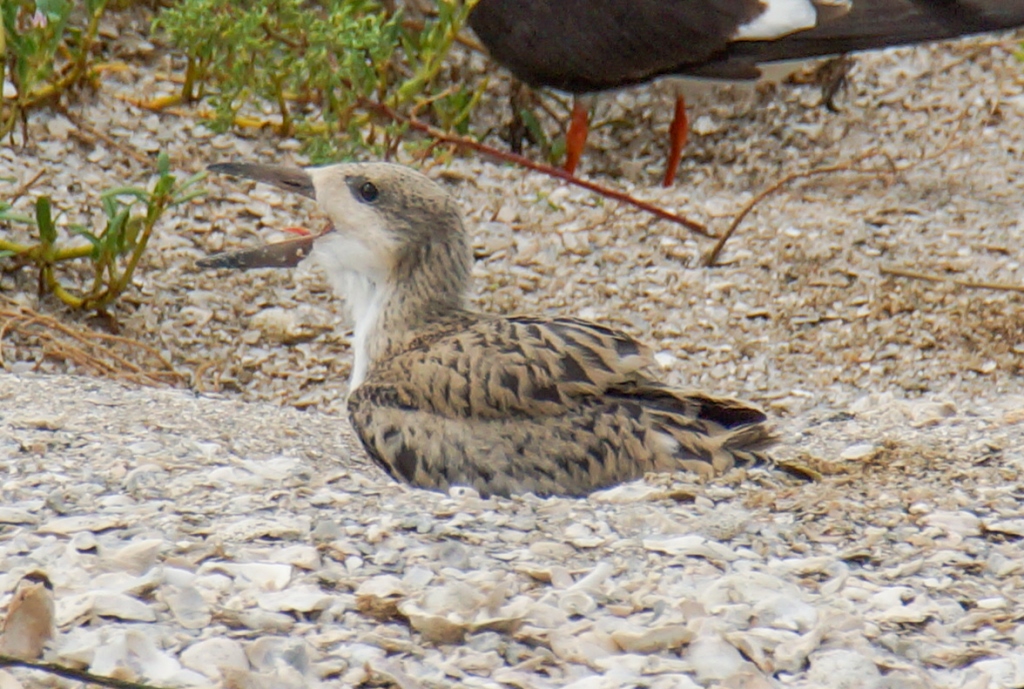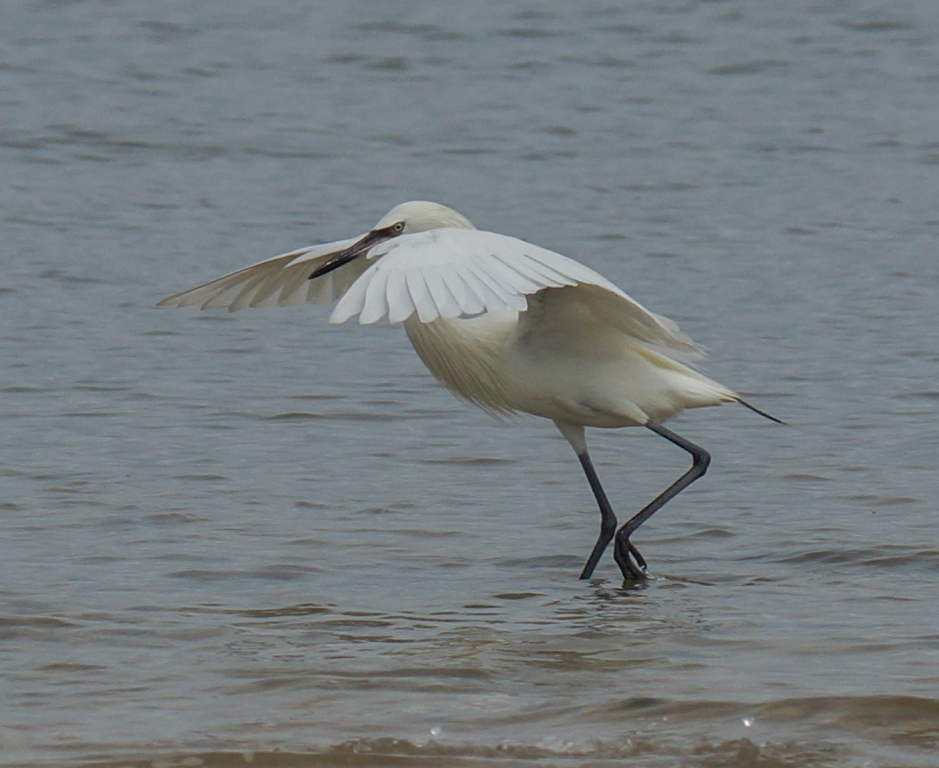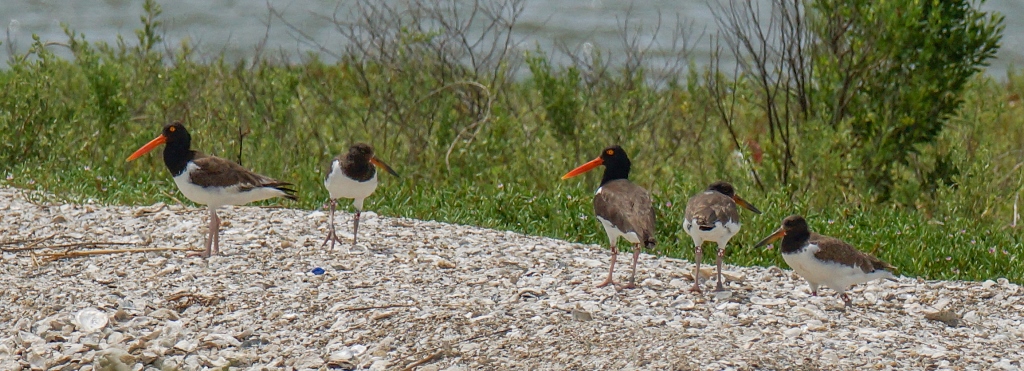By Susan Heath
This week we had to move our survey to Tuesday morning because of rainstorms predicted Wednesday and Thursday and high wind on Friday. The hourly weather from The Weather Channel showed a nice window of time with low chances of rain on Tuesday morning but the local weather on the television showed rain. What to do? Well Tuesday morning was the only option so I went with The Weather Channel and thankfully they were right. I met Alan Wilde and Lynn Wright at the boat ramp at 8:00 and we headed out. There was another chick to band and since last week a bust in that area, Lynn came along to hopefully get to enjoy that experience this week.
We headed out to Jones Bay right away. No sign of any oystercatchers until we approached FR(ed)’s area. We gave a shout of happiness when we saw that he was there with the wife and both chicks. Yeah Fred! It’s so good to see him succeed after so many years of failure. I will never tire of seeing him with his chicks acting the proud papa.
Then we moved on to CA & Y2 who had the chick that needed to be banded. We had only seen this chick once when it was just hatched but by their behavior we knew they still had one. They’d been keeping it hidden in the vegetation away from the gulls that are also nesting on the island. It’s a major feat that they managed to raise a chick on this very small island where at least 10 pairs of Laughing Gulls also nest. When we arrived we saw both adults out on a small shell bank on one side of the island the chick was with them! Yes! It is now big enough that the gulls are no longer a threat and that is a very good thing.
There isn’t much room to run on this small island so I was hoping the chick would choose to hide instead of run. No luck there however. It ran down to the other end of the island and when the terra firma ran out and I was still coming at it, it jumped into the water and dove. I wasn’t able to get there fast enough to snag it on the first dive so I waded out in the water in the direction it was heading. I didn’t see it when it came up but I heard Alan yell “to your left” and there it was. It helps to have helpers! I headed that way and it dove again but this time I was able to snag it in the dip net. We got it banded pretty quickly (W6W) and after many years of supporting this project Lynn got to hold her first oystercatcher chick. Such a treat!
Then we let it go and got away as quickly as possible. It ran to the other end of the island again and again jumped in the water. This time we circled the boat around and put it between the chick and the open bay so the chick would head back to the island. It did just that and CA & Y2 were waiting for it when it got there. Phew. I was glad when that was over. It is always stressful catching and banding chicks because you don’t want anything to happen to them after the parents worked so hard to raise them!
We headed down the length of Marker 52 and found W5 & JC standing on a shell bank. They took off as soon as they realized we’d seen them. They’ve been acting a bit weird since it was time for their nest to hatch but I don’t think they have a chick. If they do, they are leaving it unattended a lot. JJ was standing on his beach alone and I thought maybe he was guarding a single egg nest but I couldn’t find one. The latest I’ve ever found a new nest is June 21 so I’d be surprised if I found a new one now. The birds are always surprising me though.
Then we went to check J6 & UF’s island to see if we could see the miracle chicks. Instead we found UF there with an unbanded adult. Oh no! Did something happen to J6?
We haven’t seen J6 since the high tide that we thought drowned the chicks and that was back in March. We assumed he was hanging out wherever they brought the chicks during the high tide but perhaps that was incorrect. J6 was an adult when I banded him in May 2011 so I don’t know how old he is. He had to be at least three (because that’s when they reach breeding maturity) but was probably more like four or five when banded. Now that I’ve been watching these birds for 10 years I’ve seen that seems to be about the time a young male can work its way into a territory. If so, he’s 13 or 14 years old now and possibly older. That’s a pretty old oystercatcher. T6 and P4, both females, are the only other birds banded as adults in 2011 that are still around. It’s so sad to see these birds that I’ve been watching for so long disappear as they get too old to maintain a territory.
Even sadder is that I don’t know what happens to them. If a younger male comes along and tries to take the territory, does the older male just fight to hang on to it until he dies? Once a male disappears from his territory I never see them again leading me to believe they aren’t alive anymore. But on the other hand, five pairs disappeared from South Deer just before the breeding season this year and we haven’t seen any of them again. They couldn’t have all died in unison so I just don’t know. Where do old oystercatchers go to retire? Maybe there’s a giant reef out there somewhere full of aging oystercatchers just living it up on tasty bits. That’s a good thought. I’m sure that’s it.
I was already mad at UF for running P4 off as J6’s mate. Now she’s dug herself in deeper by letting J6 disappear! Oh well. She’s a survivor that one. We moved on to check on YM & JH’s chick on North Deer. They were in their usual spot and the chick was with them so I guess they are able to keep it safe from the pelicans without having to hide it in the spartina. There were so many pelicans in the way Alan was only able to get this photo of the chick!
On the backside of North Deer we found C1A alone on a shell bank but he flew off when we saw him.
E6A & unbanded were also standing on a shell bank in their territory away from the pelican hoard. I suspect they were just enjoying a bit of peace from all those big feet and giant bills.
We headed over to South Deer and found F1A standing alone in his territory No sign of his mate E2A. I’ve been suspicious they might have a chick but I think that is wishful thinking. We moved on and found Y7 & unbanded standing on a shell bank a little further on. This is not where they tried to nest but other pairs have had success there so maybe they will move. They flew off when we approached to closely. We also saw this very handsome Roseate Spoonbill. So pretty!
On the other side of the island we saw A5A & unbanded back where they tried to nest early in the season. They also flew off when we approached. Why does no one like us?
No other oystercatchers there but the Royal Tern chicks are getting big!
We headed over to check on Gangs Bayou but noticed a lone oystercatcher on one of the docks on the way so we checked it out. It was 16 still alone and now not even in his territory anymore. Man I really feel for this bird. He’s had a rough go of it and he’s getting old too. Perhaps it’s time to retire 16. You’ve earned it but I will miss you if you go! For some reason I think he looks rather cute in this photo.
Over on Gangs Bayou we found two unbanded birds and A1A strung out along the breakwater. A4A was hanging out on a shell bank near where the nest was but the egg was gone. It was time for it to hatch but there was no sign of a chick and I’d think A4A’s mate would have been there if there was a chick. That was the last nest so it appears YM & JH’s will be the last chick to fledge.
On the way back up to Jigsaw we found W2Y & unbanded and YK & unbanded on a dock. YK & unbanded have been hanging out in 16’s territory but we haven’t seen W2Y & unbanded in a territory. It’ll be interesting to see where they end up next year.
We went to Jigsaw then to see what the deal was with LH & T6 and confirm the either had a chick or they didn’t. If they did, it would have fledged by now so it should have been with them but they were alone on a shell bank. They seemed upset at our approach and did a bit of cocked tail display and calling. Hey it’s not our fault you couldn’t keep your chick safe! T6 is another of the older birds. I bet she won’t be around much longer.
YE & unbanded who also should have had a chick (this one we saw a couple weeks ago) were also out on a reef with no chick so it appears both pairs will be chickless this year.
We checked out Struve mostly for the skimmers because the oystercatchers are all done there. HM & X7 were on their rock wall with both their chicks and LT & JA were on one of the docks with all three of their chicks. The other adults were on the island just hanging out. 12 & unbanded had one of their chicks with them but the other two didn’t seem to be present. The skimmers are going strong and I videoed them for counting later. We saw about 15 big chicks. Time to start banding them! I neglected to bring the bands so we’ll have to start doing that next week.
We also saw a very nice dance by a white Reddish Egret. Another beautiful bird!
It was time to head up to Swan Lake but of course the railroad bridge was down. Alan and I had both been watching it all morning. It was up all morning until we headed to Jigsaw and then it went down. Alan joked that it saw us coming! Since it was still down, we headed out into the bay to check on the Brown Boobies. As we approached we saw a booby in flight come in and land on the shell marker sign which displaced a frigatebird that had been there with the other four boobies. The frigatebird made a short circling flight and came back to land on the sign again but missed the landing and had to circle again. It was kind of comical watching it trying to land among the already crowded sign. There are four of those signs. Why do they all want to be on that one? It eventually made a safe landing and cozied up to the boobies.
The danged bridge was still down so we went back to North Deer to try for another photo op with YM & JH’s chick. That was a total failure though. They were there but the chick must have been hiding somewhere because we didn’t even see it. Finally the bridge went back up so we zoomed up to Swan Lake. We didn’t really need to go there because all the birds up there are done but who can resist going to see the triplets up there if you get a chance? Fortunately they were there with their parents and Alan got a nice family shot.
We could see rain off in the distance which was making me nervous and we were done so we headed back down to West Galveston Bay and to the boat ramp. Fortunately the railroad bridge stayed up and we didn’t have to wait. Just as we got the boat loaded on the trailer the wind picked up and the skies turned dark. We finished just in time! I had to drive through some rain on the way back to GCBO but at least this time I didn’t have a blowout. Those new tires are nice!
If you like oystercatchers and you want to support this project, you can make a donation (thank you!) on our website here. And how could anyone not like oystercatchers!
Current Stats for upper Texas coast from Dickinson Bay to East Matagorda Bay: 0 nest being incubated, 41 failed nests, 2 nests with unfledged chicks, 1 nest with undetermined status, 21 chicks fledged
Note: All trapping and banding for this project is in accordance with federal and state permits issued to Susan Heath, GCBO Director of Conservation Research. Bird handling by volunteers is only permitted in the presence of Susan Heath and volunteers are trained in proper bird handling techniques.

